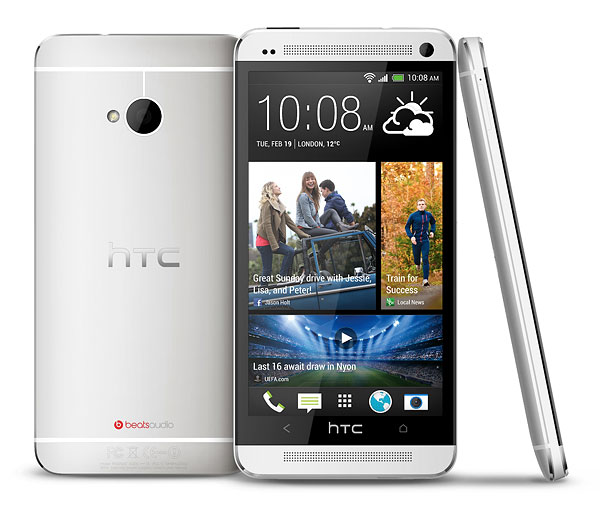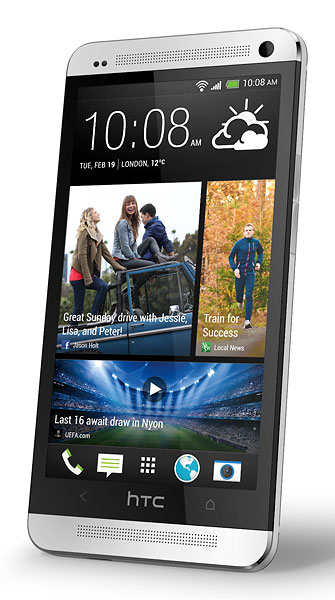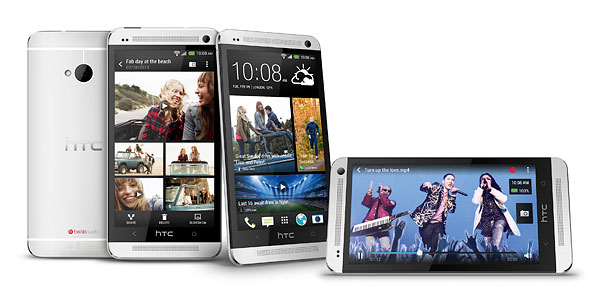HTC One smartphone debuts; uprated camera boldly favors sensitivity over resolution
posted Wednesday, February 20, 2013 at 3:09 AM EDT

For a few weeks now, rumors have been swirling about the latest flagship smartphone from Taiwan's HTC Corp., after leaks from the European press suggested the possibility that it took a new approach to digital imaging, and might perhaps bear a Foveon-like full-color image sensor. Today, the company finally took the wraps off that new phone, and it turned out that while the brand-new HTC One does indeed take a different path to many of its rivals, the rumors were far wide of the mark.
Where the rumor mill tripped up is in HTC's branding of its new phone. Instead of a full-color sensor, the HTC One differentiates itself with a 1/3-inch type BSI CMOS image sensor that's almost 12% larger than the 1/3.2-inch type of the preceding One X and One X+ in terms of surface area. In an attempt to distance itself from the long-worshipped megapixel, HTC brands its chip as an "UltraPixel sensor", a term that seems to suggest either far greater resolution, or some major breakthrough in pixel design. The truth is rather more prosaic -- along with the modest increase in sensor size, HTC has simply slashed resolution in half to allow a greater photodiode size.
Don't misunderstand, that is likely to be very good news for low-light sensitivity and image noise, it's just unfortunate that the branding is so confusing. (And making it even more so is the fact that the combination of lens, sensor, and image processor is also branded, with the trio making up what HTC calls the Zoe camera.) You have to go out of your way to find Zoe's actual resolution. It's not listed on the spec sheet, nor on the product page on HTC's website. Instead, you must go to a separate section of the HTC site marketing the UltraPixel sensor, and read clear thru to the third page before you finally reach this still-important specification. We'll save you the trouble -- where the earlier HTC One X and One X+ bore an eight-megapixel sensor and many rivals now offer 13-megapixel chips, the HTC One opts for a relatively low four-megapixel resolution.
It's a bold, if not unprecedented move. (Back in 2009, Canon did much the same thing with the PowerShot G11, slashing resolution from its predecessor's 14.7-megapixels to just 10-megapixels. 2011's PowerShot SX40 HS repeated the feat, albeit with a more modest cut of two megapixels from the 14.1-megapixel SX30 HS.) We can't recall any flagship product having its resolution cut by as much as half, though. Unusually, the image sensor has a 16:9-aspect ratio, matching that of the phone's screen, but not the aspect ratios of standard consumer photo prints. Images are output at a resolution of 2,688 x 1,520, which even at 300dpi is enough for a 5" x 7" print with some horizontal cropping to match the aspect ratio of the print.
That decision gifts the HTC One with a relatively generous pixel pitch of 2.0µm. By comparison, current camera phone sensors typically have somewhere in the region of a 1.4µm pixel at eight megapixels, and 1.1µm at 13 megapixels. And that's not just generous by camera phone standards; many dedicated compact cameras these days have smaller photodiodes. The closest current model in terms of pixel pitch that we can recall is the Panasonic LX7 -- its pitch is near-identical, although its sensor is significantly larger. Imagine taking a four megapixel crop from the center of an LX7 image, but using a slightly less bright, less complex, five element 3.82mm prime lens, and you have at least a general indication of what could be possible from the HTC One with modern technology.

Of course, the lens has its part to play too. Here, HTC has opted for a 28mm-equivalent, f/2.0 prime lens, which is similar in basic specification to that which it used in the One X and One X+. While, like most camera phones, there's no optical zoom, it is certainly brighter than average even when compared to compact cameras. It's also rare indeed by camera phone standards, because it includes true dual-axis optical image stabilization, which should make it even easier to get a useful photo in low ambient light, so long as your subject is relatively static. HTC claims that its OIS system's refresh rate of 2000Hz is "much faster than any comparable phone camera with OIS", and can correct for up to 1-degree of tilt in all directions from its center-point.
The company also notes a full-resolution maximum shutter speed of 1/48th second, and suggests that competitors and its own HTC One X are limited to 1/30th second. (This seems rather an odd assertion; we've seen many phone cameras claiming much faster shutter speeds; we can't confirm specifically for the One X, however, as it fails to write a shutter speed in the EXIF headers of its images at all.)
Another important difference is that the HTC One's lens doesn't protrude from the camera body. The earlier models both had a somewhat ungainly-looking lens bezel that projected a short distance from the rear of the camera. Although it wasn't enough to be uncomfortable in your pocket, it meant that when the phone was placed display-up, the lens bezel itself was in direct contact with the surface beneath, and the easily-scratched, flush-mounted lens cover glass was just a fraction of a millimeter above the surface. It looks as if the HTC One's lens cover glass is recessed ever so slightly, so perhaps it will prove less prone to harm in this respect.

As did its immediate predecessors, the HTC One has a built-in LED lamp adjacent to the lens that acts as a flash strobe. HTC doesn't provide any information on output strength, so it's not yet clear if this has been upgraded, but we do know that it still offers a five-level automatic strength adjustment.
There is, of course, still a front camera for video calling, as well. This has increased in resolution just slightly to 2.1 megapixels, enough for a Full HD video stream. (By contrast, the HTC One X had a rather unsatisfying 1.3 megapixel front camera, and the One X+ boosted this to 1.6 megapixels, while significantly improving image quality by piping its output through the proprietary ImageSense image processor.) The front lens, says HTC, offers an 88-degree field of view.
HTC has also upgraded the image processor in its new flagship smartphone. Gone is the ImageSense chip of the One X and One X+, replaced by a new ImageChip 2-branded image processor. This allows burst shooting at up to eight frames per second, double the rate of the HTC One X and One X+. It also provides for a claimed ~84dB HDR video capture function, achieved by shooting interlaced 60 fields-per-second video with variant exposure for each field, then combining the results to create a video feed with expanded dynamic range. HDR videos have a somewhat unusual 28 frames-per-second capture rate, however. The new processor also enables full-range focusing in a manufacturer-claimed 0.2 seconds, plus in-phone noise reduction and correction of vignetting / color shading. The HTC One also provides retouching options including a smile tool and object removal function.
When not using the HDR function, the HTC One can record Full HD video at a rate of 30 frames per second, 720p video at 60 frames per second, and non-standard 768 x 432 pixel video at up to 96fps. This last can be played back at variable speeds in-camera. Videos use H.264 High Profile compression, with a bitrate of up to 20mbps.

That, in a very large nutshell, is the camera functionality of the HTC One. Of course, there's a lot more to it -- this is a smartphone, after all, and so is essentially a small, powerful, mobile touchscreen computer. At its heart is a 1.7 GHz, quad-core Qualcomm Snapdragon 600 system-on-chip, replacing the Tegra 3 SoC found in the One X+ and GSM variants of the HTC One X, as well as the Snapdragon S4 found in the US-market One X. On the front panel is a much higher-resolution -- some would say overkill, given the screen size and viewing distances -- 1080p Full HD display with 468 ppi dot pitch, and a diagonal of 4.7 inches. (The earlier models had the same screen size, but with a 312 ppi dot pitch and 720p resolution. Their display was widely praised as best-in-class for last year's smartphones.)
There's also either 32GB or 64GB of storage and 2GB of DDR2 memory, the latter being double that found in the earlier flagships, and a new front-facing stereo audio system with hardware amps for both speakers. The built-in, non-removable battery has been uprated to 2300mAh (~10% more than the One X+, and 28% more than the One X). All of this is wrapped in a new body combining aluminum panels front and rear, and plastic panels at the sides, in place of the surprisingly rugged polycarbonate unibody of the HTC One X and One X+. Although width and depth are almost unchanged, height and weight have both increased a little to accomodate the stereo speakers, and the Recent Apps hard-button has been forfeited in favor of fitting in HTC's logo beneath the screen, leaving only two hard-buttons.
In the US market, the HTC One is expected to be available from AT&T, Sprint, and T-Mobile, but not so far from Verizon. None of these have so far provided any info on pricing or availability. Globally, HTC claims that 185 mobile operators and retailers will carry the One, and that availability starts from March 2013. Like its predecessors, the HTC One comes bundled with 25GB of free storage on Dropbox for a two-year term.
More details on the HTC website.